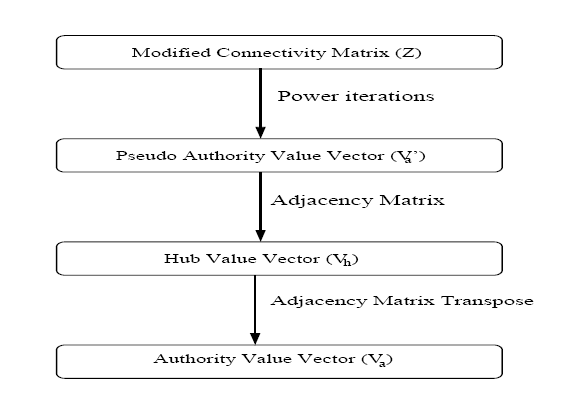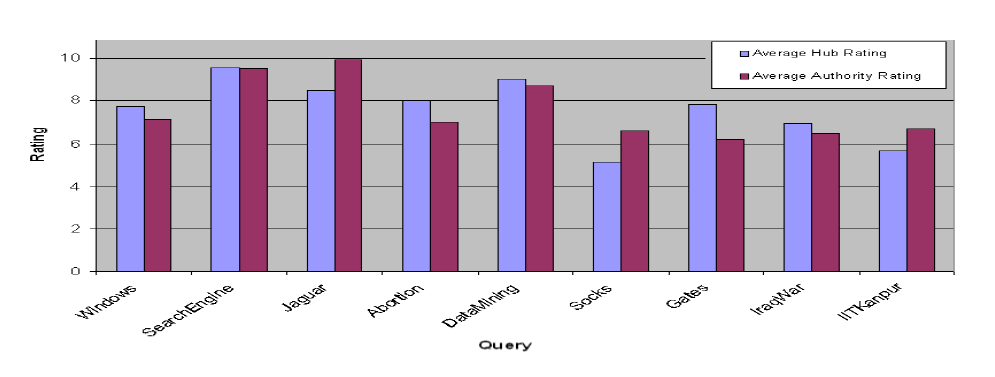
Figure 1: HITS Algorithm
Searching information on the WWW is now a common practice. Traditional information retrieval techniques are not sufficient for searching information on the WWW. Kleinberg's HITS algorithm [2] is a well known algorithm for answering broad-topic queries in hyperlinked environment. We improve it by selectively choosing the candidate set of pages for ranking and novel approach to ranking the pages. Section 2 briefly describes the original HITS algorithm. Section 3 introduces our SelHITS algorithm. Section 4 summarizes the initial experimental results and conclude the paper.
HITS algorithm [2] is briefly outlined in Figure 1. It associates two scores with each page. Authority which is a measure of authoritative information contained in the page and Hub which is a measure of links to good authorities. Using some existing search system, HITS algorithm gets a set of relevant pages for user query. This is referred to as the root set. Then all the pages from one link neighborhood of the root set are added to the root set. This is referred to as the base set. Consider a page Pi. Let Pari be set of pages which have hyperlink to Pi and are present in the base set. Let Chii be set of pages that Pi has hyperlink to and are present in the base set. Let hub value for Pi be denoted as Hi and authority value as Hi. Then Ai = ΣlεPari Hl and Hi = ΣlεChii Al. If E is the adjacency matrix for the base set, then authority vector Va is calculated as Va = ETEVa. The vector Va converges to the principal eigenvector of ETE. The matrix ETE is real, symmetric and non-negative. Hence its principal eigenvector is real and non-negative. Hub vector Vh is calculated as Vh = EVa. Lagville et al. [3] present a comprehensive survey of various modifications proposed for HITS and other eigenvector based algorithms for web information retrieval.
SleHITS algorithm is briefly outlined in Figure 2. It is motivated by following observations. First, considering just page to page connectivity ignores other latent information in the WWW. For example, if multiple pages from same host are present in the root set then it indicates that there exists a community of pages on that host and it is relevant to the query topic. This context of location of pages is ignored by HITS algorithm. To exploit such latent information in the hyperlinked environment, we propose a novel approach to calculate hub and authority values along with the concept of virtual links. Many pages added to the root set in the expansion step of HITS algorithm are irrelevant or noisy. They substantially degrade the quality of results. We should be selective in expanding the root set. For ambiguous queries we should be able to distill pure topic i.e. giving results consistent with only one interpretation of the query. Now we describe proposed improvements to address these problems.

Figure 1: HITS Algorithm

Figure 2: SelHITS Algorithm
We consider two types of links for ranking. Actual links are those hyperlinks which are actually present between different pages. Virtual links are the pseudo links that we hypothetically insert. If a page Pi has actual link to page Pj in the root set then we insert pseudo links from Pi to all other pages in the root set which reside on the same host as that of Pj. Considering virtual links helps exploit the context of location of a page. For a given root set, consider adjacency matrix E. E[i,j] = 1 if Pi has actual link to Pj. We define modified adjacency matrix Z such that Z[i,j] = 1 if Pi has actual or virtual link to Pj. Then hub and authority vectors for the root set are calculated as shown in Figure 3. Same can be represented in equation form as Va' = ZTZVa'. First, calculating pseudo authority values assigns same authority value to all pages on one host as we are considering virtual links. Then actual hub values are calculated using these pseudo authority values as Vh = EVa'. This calculation of hub vector boosts hub values for those pages which have hyperlink to hosts which contain more pages in the root set. Finally actual authority values are calculated as Va = ETVh. This is required as initial authority values of some pages are unnecessarily boosted because of virtual links. We calculate hub and authority values twice, once on the root set and once on the base set, as illustrated in Figure 2.

Figure 3: Calculating Hub and Authority Values
After calculating hub and authority values on the root set, we select top 20 hubs and top 20 authorities for expansion. Good hubs point to good authorities [2], so we add outlinks of top 20 hubs to the root set. Good authorities are pointed by good hubs [2], so we add inlinks of top 20 authorities to the root set. As compared to HITS algorithm, this selective expansion procedure drastically reduces size of the base set and avoids topic drift as irrelevant pages are not added to the root set. If query is ambiguous then we have corresponding disjoint communities in the link structure [2]. Top hubs and authorities are from the same community as hub and authority values are mutually reinforcing. Selective expansion procedure adds new pages from single community, which further boosts hub and authority values for that community. Hence we are able to give results consistent with only one interpretation of the query. If user is interested in other interpretation of the query then we can simply remove current community from candidate pages and again run our algorithm.
We tested our algorithm for 9 sample queries. We observed significant topic drift with HITS algorithm for these queries. For each query we generated top 20 hubs and top 20 authorities by SelHITS algorithm. Each query results were evaluated by 3 different users on the scale of 0 to 10. Figure 4 shows average scores for each query. Within each query, scores for hubs and authority are similar. Also, we noticed that scores of different users for a given query were also similar. So we can infer that there exists a notion of quality of search results within users. For ambiguous queries, we got results consistent with only one interpretation of the query. For example, for query "gates" all results were related to "Bill Gates". More details about experimental results are available at [1].

Figure 4: Average Ratings for Hubs and Authority
We briefly discussed the SelHITS algorithm which is an improvement over Kleinberg's HITS algorithm for answering broad-topic queries. Novel approach to calculate hub, authority values and selective expansion of the root set are the main contributions of our work. Brief experimental evaluation suggests that algorithm performs satisfactorily. We are currently working on extensively testing the proposed algorithm for variety of queries and applying the same algorithm for focused crawling problem.
[1] , http://www4.ncsu.edu/~acawekar/SelHITSResults/,
[2] , Authoritative sources in a hyperlinked environment, Journal of the ACM 47 (5--7): 604--632, 1999
[3] , A survey of eigenvectormethods of web information retrieval, SIAM Rev. 46 (1): 135--161, 2005